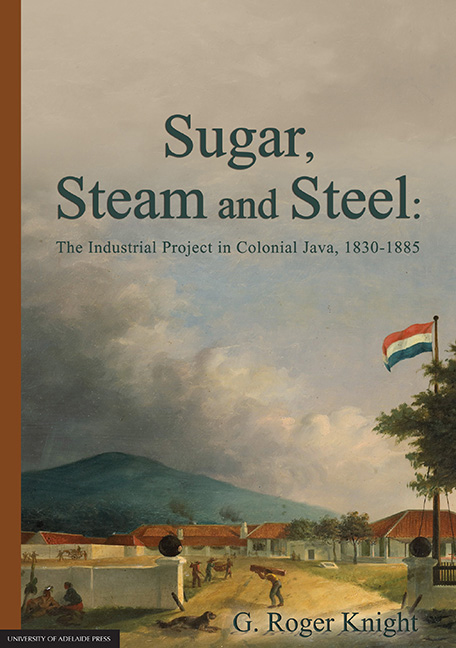Book contents
- Frontmatter
- Contents
- Abbreviations and Glossary
- Acknowledgements
- Introduction: Java Sugar, an Industrial Project and the ‘Oriental Cuba’, 1830-85
- Part I The ‘Industrial Revolution’ in Sugar Manufacture
- 1 Java's Singular Trajectory: Steam, Steel and the Industrial Project in Sugar
- 2 A Creole Prometheus: Steam, Paddle Boats and Sugar Factories
- 3 The Industrial Sugar Factory: Wonopringgo, Thomas Edwards and the Nederlandsche Handel-Maatschappij (NHM)
- Part II The ‘Peasant’ Economy, the Money Trail and the Bourgeoisie
- Part III Metamorphosis
- Conclusion: The Future of an Industrial Project: The 1880s and Beyond
- Archival Sources
- Bibliography
3 - The Industrial Sugar Factory: Wonopringgo, Thomas Edwards and the Nederlandsche Handel-Maatschappij (NHM)
from Part I - The ‘Industrial Revolution’ in Sugar Manufacture
Published online by Cambridge University Press: 24 October 2017
- Frontmatter
- Contents
- Abbreviations and Glossary
- Acknowledgements
- Introduction: Java Sugar, an Industrial Project and the ‘Oriental Cuba’, 1830-85
- Part I The ‘Industrial Revolution’ in Sugar Manufacture
- 1 Java's Singular Trajectory: Steam, Steel and the Industrial Project in Sugar
- 2 A Creole Prometheus: Steam, Paddle Boats and Sugar Factories
- 3 The Industrial Sugar Factory: Wonopringgo, Thomas Edwards and the Nederlandsche Handel-Maatschappij (NHM)
- Part II The ‘Peasant’ Economy, the Money Trail and the Bourgeoisie
- Part III Metamorphosis
- Conclusion: The Future of an Industrial Project: The 1880s and Beyond
- Archival Sources
- Bibliography
Summary
As late as the 1870s, a painter's representation of a sugar factory on the north coast of Central Java made conspicuous reference to its purportedly picturesque aspects. The place appears to be located in wilderness; a few ‘blacks’, as they would have been referred to then (it might be a particularly remote part of the Caribbean), are scattered in desultory fashion in the foreground; and a ‘pioneering’ European cabin bravely flies the Dutch flag. Although a belching chimney forms part of the picture, it is possible to feel that it is only there out of a need somehow to add variety to a scene otherwise totally lacking in animation or purpose. In fact, however, it is the vital clue to what was actually being depicted: an industrial site in constant dayand- night operation for a substantial part of the year, operating with a disciplined workforce of several hundred labourers, its grinding mills fed with rail-hauled cane and, within its walls and in day-and-night operation, an array of apparatus that was fully the match (by the time the painting was made) for most other leading sectors of the contemporary international sugar economy.
The rise of the industrial factory was central to all this. As has been widely observed, the arrival of steam operation and more specifically, though not exclusively, the steam engine, entailed the need for economies of scale to justify its use wherever it was installed. Technological advance necessitated larger units of production and the concentration of production in one place. It also raised issues of how to concentrate labour in a single location and how to subject labour to the degree of discipline which large units of production require if they are to operate smoothly — or indeed, operate at all. Unsurprisingly, these were all issues played out within the context of the industrial project in sugar which got underway in Java during the 1830s and 1840s and developed exponentially thereafter.
There is, of course, no single pace-setting model of what constitutes 'industrialisation', and the immediate focus here is on technological innovation. This, far from constituting a clean and decisive break with the past, took place (at least until late in the nineteenth century) on a largely incremental basis that mixed the new with the old in a myriad of possible permutations.
- Type
- Chapter
- Information
- Sugar, Steam and SteelThe Industrial Project in Colonial Java, 1830-1885, pp. 63 - 92Publisher: The University of Adelaide PressPrint publication year: 2015

